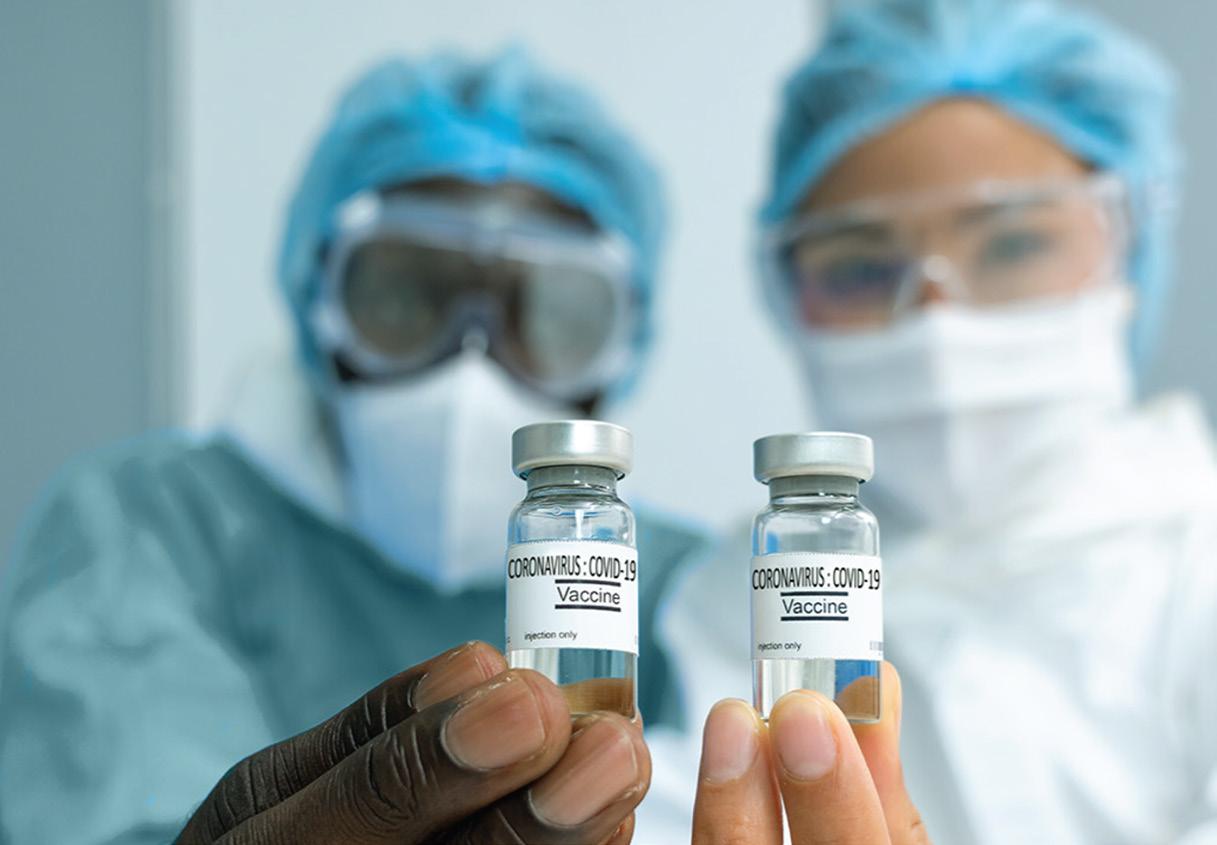
14 minute read
AMA News
COVID-19 VACCINE HESITANCY: 10 TIPS FOR TALKING WITH PATIENTS
By: Tanya Albert Henry, Contributing News Writer Physicians have their work cut out for them in trying to get patients to take a COVID-19 vaccine. In early December, just 56% of people told researchers that they were somewhat or very likely to be vaccinated, according to a research letter published in JAMA. On top of that, 29% of people who work in a health care delivery setting told pollsters for the Kaiser Family Foundation (KFF) that they probably would not or definitely would not get a COVID-19 vaccine, even if it were available for free and scientists had deemed it safe.
Advertisement
So, what are some things to do to help your patients move from vaccine hesitancy to vaccine acceptance? Internist Marie T. Brown, MD, the AMA’s director of practice redesign, discussed strategies during a recent AMA webinar, “Vaccinations: Roadmap for Success.” She also joined infectious disease specialist Constance A. Benson, MD, a professor of medicine and global public health at University of California, San Diego, in discussing tips during a recent episode of “AMA COVID-19 Update.” Here are some of their suggestions.
Understand your patients’ concerns
Some Black patients may be hesitant because of mistrust in the medical community stemming from experiences such as the Tuskegee syphilis study; some Hispanics may be hesitant because of a more general mistrust of the government stemming from immigration or border-patrol experiences. Physicians should try to meet patients in the middle and build trust, recognizing what has happened so they can then move forward.
Ask why a patient is hesitant
If someone declines the vaccine, you can say, “May I ask why? What have you heard in your community?” It is a less judgmental way to find out what they may be thinking, giving patients the opportunity to give frank voice to concerns they might have while attributing them to others.
Counter any misinformation
People hear and see a lot of misinformation in their social circles and on social media. Pew Research Center found that substantial minorities believed in COVID-19-related conspiracy theories. As a physician, you need to correct any misinformation a patient may give for not getting the vaccine.
Know you are the most trusted information source
Physicians can be effective in countering vaccine misinformation, said Dr. Brown, who is also a professor of internal medicine at Rush University Medical College. KFF research found that a person’s own physician or health care provider is the most trusted source for information on the COVID-19 vaccine, with 85% of respondents holding this belief no matter their gender, sex, ethnicity or political belief.
Tell patients they need to get the vaccine
Adult patients say the second biggest reason they don’t get an immunization is that a “doctor hasn’t told me I need it,” according to a 2008 study in the American Journal of Medicine, “Barriers to Adult Immunization.” Saying nothing is saying something, Dr. Brown noted.
Tailor your message
To reach people no matter their political view—or whether they believe a vaccine is a personal choice or collective responsibility—focus the discussion on how getting a vaccine can help protect a loved one such as a grandparent, a child or someone who is immunocompromised.
Address patients’ fears about side effects
Start a conversation by asking a patient how they felt after their last vaccination, such as a flu shot. Ask if they had any side effects or other reaction. Then you can move the conversation to tell them the COVID-19 vaccine is not much different and prepare them for the possible side effects they may experience. Preparing patients to expect muscle aches and fatigue if a second dose is required can help prevent them from worrying that the vaccine “gave them the disease,” calling you with concerns and more importantly discouraging their family and friends from getting vaccinated. Hope for the best but prepare them for the worst.
Prepare your staff to answer questions
The AMA has produced a COVID-19 vaccine script for patient inquiries to help physicians and their staff answer patient questions. The AMA has developed documents to answer frequently asked questions about COVID-19 vaccination: one is aimed at physicians, and the other addresses patient queries.
Show your vaccination pride
Everyone in your office who is vaccinated can wear a button or sticker showing they received their COVID-19 shot, reinforcing to people that the vaccine is safe and that you trust in it.
Tell stories to make impact
The public tends to weigh risks and benefits differently than physicians do, so telling stories that illustrate why the vaccine is important will have a stronger impact on patients. • Price deviations and fluctuations that make pricing seem too good to be true. • Advertising “unlimited stock” when there is an industry wide shortage. • Contact email addresses unconnected to the website • Bad grammar, typos and other errors. • Cookie-cutter websites that mix up names or logos, appear unfinished, have nonsensical privacy policy text or broken links.
A NIOSH-approved mask will feature these markings on the exterior of respirator: • Approval number. • Brand name, registered trademark or easily understood abbreviation. • NIOSH name in block letters, or NIOSH logo. • Filter class (N, P or R) and filter efficiency level (95, 99 or 100). • Lot number – recommended, but not required. • Model number.
Learn more about how to spot counterfeit respirators at the NIOSH National Personal Protective Technology Laboratory, which features a listing – with pictures – of masks that are wrongly being marketed as having NIOSH approval. Meanwhile, NIOSH maintains a list of approved filtering facepiece respirators by class and filtration level, with contact information for the manufacturers.
7 SIGNS THOSE NEW N95S AT YOUR PHYSICIAN PRACTICE MIGHT BE FAKE
By: Kevin B. O’Reilly, AMA News Editor The country’s leading producer of N95 respirator masks, 3M, says that more than 10 million counterfeit versions of the personal protective equipment (PPE) have been seized since the pandemic’s onset in the U.S. Even big names like the Cleveland Clinic have been duped by cleverly counterfeited N95s. Now the Centers for Disease Control and Prevention’s National Institute for Occupational Safety and Health (NIOSH) has issued a notice about the fake N95s that are circulating and how physicians and others in health care charged with obtaining PPE can properly identify them. Respirators approved by NIOSH have an agency approval label somewhere on the packaging, either on the box or included with the user instructions. Notice about approval also will appear on the filtering facepiece respirator itself, in abbreviated form.
According to NIOSH, here are seven signs of counterfeit respirators that physicians and staffers at medical groups and health systems should look for: • No markings at all on the filtering facepiece respirator. • No approval number on filtering facepiece respirator or headband. • No NIOSH markings. • NIOSH spelled incorrectly. • Presence of decorative fabric or other decorative add-ons. • Claims of approval for children – NIOSH does not approve any type of respiratory protection for children. • Filtering facepiece respirator has ear loops instead of headbands

The agency also warns about these potential red flags to look for before placing large orders from third-party marketplaces or websites you haven’t ordered from before: • If a listing claims to be “legitimate” and “genuine,” it likely is not. • Examine transactions history and feedback if possible. • Fluctuations of items marketed over time – high or low periods of transactions.
WHY IT’S TIME TO INVEST IN THE NATION’S HEALTH CARE WORKFORCE
By: Andis Robeznieks, AMA Senior News Writer What’s the news: The AMA is supporting a bipartisan Senate bill, the “Strengthening America’s Health Care Readiness Act,” that would help grow the nation’s pipeline of future physicians and nurses while creating opportunities to diversify the health workforce. “As the nation faces a pandemic and multiple health professional shortages, sustained, long-term investments in workforce programs are necessary to help care for our nation’s most vulnerable populations,” AMA Executive Vice President and CEO James L. Madara, MD, wrote in a letter of support to the bill’s sponsors, Sens. Dick Durbin, D-Ill., and Marco Rubio, R-Fla. The bill also recognizes the crushing student debt that can entrap and limit the career decisions of new health professionals upon graduation, and it provides for scholarships and debt forgiveness in exchange for a commitment to work and practice in Health Professional Shortage Areas (HPSAs). “This vital legislation will help to sustain the current workforce during the pandemic and help maintain a robust pipeline of

providers for future health emergencies,” Dr. Madara’s letter adds.
Why it’s important: The bill would offer a one-time supplemental appropriation of $5 billion in emergency surge funding for scholarships and loan forgiveness awards through the National Health Service Corps (NHSC), plus $1 billion through the Nurse Corps. In addition, 40% would be set aside for students from low-income communities and those from racial and ethnic populations that have been historically underrepresented in health professions. “The COVID-19 pandemic has highlighted the need for additional emergency capacities and underscored the health workforce shortages and disparities that exist throughout the nation,” Dr. Madara wrote. “This bill would bring access to care for patients and welcome relief to the physicians, residents, and nurses who have been on the front lines throughout the pandemic caring for our sickest patients.” And, while existing programs have had some success recruiting professionals to work in underserved areas, the NHSC and Nurse Corps “still fall short of fulfilling the health care needs” of all HPSAs, Dr. Madara’s letter says. Additionally, the bill would create an annual allocation of up to $50 million from 2022 through 2026 to establish a NHSC Emergency Service demonstration project involving current NHSC participants or alumni of the program, aiding in our surge capacity efforts during national disasters by allowing them to serve in the National Disaster Medical System. This demonstration project provides a pathway for individuals to receive supplemental loan repayments in exchange for improving the nation’s disaster preparedness and surge capacity. What’s next: The bill has been referred to the Senate Health, Education, Labor and Pensions Committee but no further action has been taken.
“COVID-19 has demonstrated the need for a national policy that increases the number of health workers to address shortages, medical disparities, and respond to emergencies,” Durbin, the Senate Majority Whip, said in a news release.
WHY BULLYING HAPPENS IN HEALTH CARE AND HOW TO STOP IT
By: Brendan Murphy, AMA News Writer Poor staffing levels, excessive workloads, subpar management skills, stress and lack of autonomy are some of the factors that contribute to bullying in the workplace—including in medicine—according to a recent AMA report on the problem that pervades health care and how to stop it. AMA policy defines workplace bullying as “repeated, emotionally or physically abusive, disrespectful, disruptive, inappropriate, insulting, intimidating or threatening behavior targeted at a specific individual or a group of individuals that manifests from a real or perceived power imbalance and is often, but not always, intended to control, embarrass, undermine, threaten or otherwise harm the target. Individual, organizational and health system factors may contribute to the overall workplace climate or culture that allows unprofessional behavior, such as bullying, to persist.”
Why health care’s susceptible to bullies
Bullying behaviors are common across workplaces. A report from the Joint Commission indicates that bullying in the health care workplace is more common than sexual harassment and is initiated by both men and women. The hierarchical nature of health care has made it a field that is susceptible to workplace bullying. “Bullying and mistreatment of students and residents are commonplace,” said Audiey C. Kao, MD, PhD, vice president of ethics standards at the AMA. “Few of us have gone through medical education and training who have not either witnessed or been the subject of bullying by individuals in greater power and authority. It’s something that was long overlooked, but it is harmful to the learning environment and needs to be eradicated.”
Cultural shift required
The reasons to address and eliminate bullying are multifold, chief among them: Bullying behaviors among workers can adversely affect patient care, according to the report. “Patient care is delivered not by a single individual but by a team of individuals,” Dr. Kao said. “If you work in a health care environment where bullying is prevalent or even accepted or not dealt with, you’ll create an unhealthy team dynamic ... where individuals are hesitant to raise patient care issues over concerns that they will not be taken seriously because they have been bullied in the past.” Addressing workplace bullying can and must be done at an organizational level, the AMA report says. That means implementing or improving anti-bullying policies that show management’s commitment to a safe and healthy workplace. It also means creating an environment in which all workers feel comfortable speaking up, Dr. Kao said. “When you witness bullying, silence and avoidance is never an effective strategy,” he said.

Key management steps
The AMA’s report details advice on an effective workplace policy on bullying and tactics to improve organizational culture. In addition, the report says, there are two key steps for management to take: • Make the administration aware that unprofessional behavior is a threat. If the team doesn’t recognize that there is a problem, they won’t have a plan to do something about it, nor recognize the threats to quality care. • Educate the entire staff about why unprofessional or hostile behavior is a problem. If the staff recognizes that the leaders are concerned about bullying, they are more likely to come forward when they feel that bullying has occurred, or better yet, tell their co-worker that their behavior is inappropriate. Read the AMA report, “Bullying in the Health Care Workplace: A guide to prevention and mitigation.”“
SECRET WEAPON TO COMBAT PHYSICIAN STRESS: CONNECTING WITH COLLEAGUES
By: Sara Berg, AMA Senior News Writer Maintaining a masked physical distance from those living outside one’s home remains a cornerstone of preventive advice during the COVID-19 pandemic. Unfortunately, remaining physically apart has led to social isolation for many. While peer-support programs serve a vital role, they tend to only address the tip of the iceberg of the distress and disconnection experienced by many physicians. Going beyond peer-support programs, it is important to create processes for intentional professional connection, so no one delivers care alone. “We are a very isolated lot and then we’ve added this whole idea of physical or social distancing, and we find ourselves disconnected from our profession, from ourselves, from our patients and from each other,” Mark Greenawald, MD, a family physician at Carilion Clinic in Roanoke, Virginia, said during an AMA webinar on professional connection. “No one should be trying to traverse what’s been happening in health care alone,” Dr. Greenawald added. He outlined some important attributes of a culture of wellbeing and connection.
Recognize good work
Looking at service, it is important that “we recognize our teammates for their good work,” said Dr. Greenawald. “If we’re not doing that daily, particularly in the time of COVID, what’s the cost of that? “What do people take home with them for the incredible work that they’re likely doing every day if we’re not creating a culture where that just comes naturally, that it’s just built into our DNA?” he added.

Check in with your teammates
Physicians should reach out to their teammates to know more about their joys and struggles. By checking in, “I’ve learned about … things that people are carrying with them when they come to work that we know impacts their ability to show up and yet I was totally blind to so many of these things before I started checking in with folks.”
Create a positive team culture
When it comes to attitude, it is key for physicians and other health professionals to create a positive and encouraging team culture in your organization. That is because “creating a culture of encouragement and a culture of positivity becomes even more important as we navigate COVID,” said Dr. Greenawald.
Regularly connect with meaning
Dr. Greenawald cited the words of pioneering burnout researcher Christina Maslach, PhD, who said “that ultimately, when someone’s in a state of burnout, they’re experiencing what she calls an erosion of the soul. And I like to think about our work in health care as being soul work. “At the end of the day, it’s about meaning and it’s about purpose, so regularly connecting with those things becomes essential if we’re to be able to carry out our mission in terms of the work that we do,” he added.
Celebrate successes
Renewal requires individuals to take time out of their day to celebrate their successes. However, many people rarely take time to celebrate those successes.
“Think about the implications of that in the context of the incredibly challenging work that we’re doing right now,” said Dr. Greenawald. There is a growing “need more than ever to be helping to try to fill each other up as we have a lot of things that are withdrawing from us emotionally at this point in time.”
Take time for stress reduction
Physicians need to take time for self-care, stress reduction and relaxation because many “people are working harder than they have in a long time,” said Dr. Greenawald. “We were working hard at baseline, but the hours that many people are putting in would be unthinkable one year ago. “The need for some kind of reduction in stress becomes even more” important, he added. But the good news is that “we’ve got some secret weapons and those secret weapons are our relationships with each other and those relationships, in many ways, are untapped right now.”







